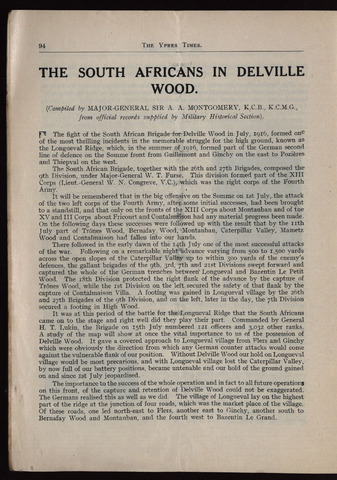THE SOUTH AFRICANS IN DELVILLE
WOOD.
94
The Ypres Times.
Compiled by MAJOR-GENERAL SIR A. A. MONTGOMERY, K.C.B., K.C.M.G.,
from official records supplied by Military Historical Section).
|H! The fight of the South African Brigade for Delville Wood in July, 1916, formed one
of the most thrilling incidents in the memorable struggle for the high ground, known as
the Longueval Ridge, which, in the summer of 1916, formed part of the German second
line of defence on the Somme front from Guillemont and Ginchv on the east to Pozières
and Thiepval on the west.
The South African Brigade, together with the 26th and 27th Brigades, composed the
9th Division, under Major-General W. T. Furse. This division formed part of the XIII
Corps (Lieut.-General W. N. Congreve, V.C.), which was the right corps of the Fourth
Army.
It will be remembered that in the big offensive on the Somme on Lst J uly, the attack
of the two left corps of the Fourth Army, after some initial successes, had been brought
to a standstill, and that only on the fronts of the XIII Corps about Montauban and of the
XV and III Corps about Fricourt and Contalmaison had any material progress been made.
On the following days these successes were followed up with the result that by the nth
July part of Trönes Wood, Bernafay Wood, Montauban, Caterpillar Valley, Mametz
Wood and Contalmaison had fallen into our hands.
There followed in the early dawn of the 14th July one of the most successful attacks
of the war. Following on a remarkable night advance varying from 500 to 1,500 yards
across the open slopes of the Caterpillar Valley up to within 300 yards of the enemy's
defences, the gallant brigades of the 9th, 3rd, 7th and 21st Divisions swept forward and
captured the whole of the German trenches between" Longueval and Bazentin Le Petit
Wood. The 18th Division protected the right flank of the advance by the capture of
Trones Wood, while the 1st Division on the left secured the safety of that flank by the
capture of Contalmaison Villa. A footing was gained in Longueval village by the 26th
and 27th Brigades of the 9th Division, and on the left, later in the day, the 7th Division
secured a footing in High Wood.
It was at this period of the battle for the Longueval Ridge that the South Africans
came on to the stage and right well did they play their part. Commanded by General
H. T. Lukin, the Brigade on 15th July numbered 121 officers and 3,032 other ranks.
A study of the map will show at once the vital importance to us of the possession of
Delville Wood. It gave a covered approach to Longueval village from Flers and Ginchy
which were obviously the direction from which any German counter attacks would come
against the vulnerable flank of our position. Without Delville Wood our hold on Longueval
village would be most precarious, and with Longueval village lost the Caterpillar Valley,
by now full of our battery positions, became untenable and our hold of the ground gained
on and since 1st July jeopardised.
The importance to the success of the whole operation and in fact to all future operations
on this front, of the capture and retention of Delville Wood could not be exaggerated.
The Germans realised this as well as we did. The village of Longueval lay on the highest
part of the ridge at the junction of four roads, which was the market place of the village.
Of these roads, one led north-east to Flers, another east to Ginchy, another south to
Bernafay Wood and Montauban, and the fourth west to Bazentin Le Grand.

